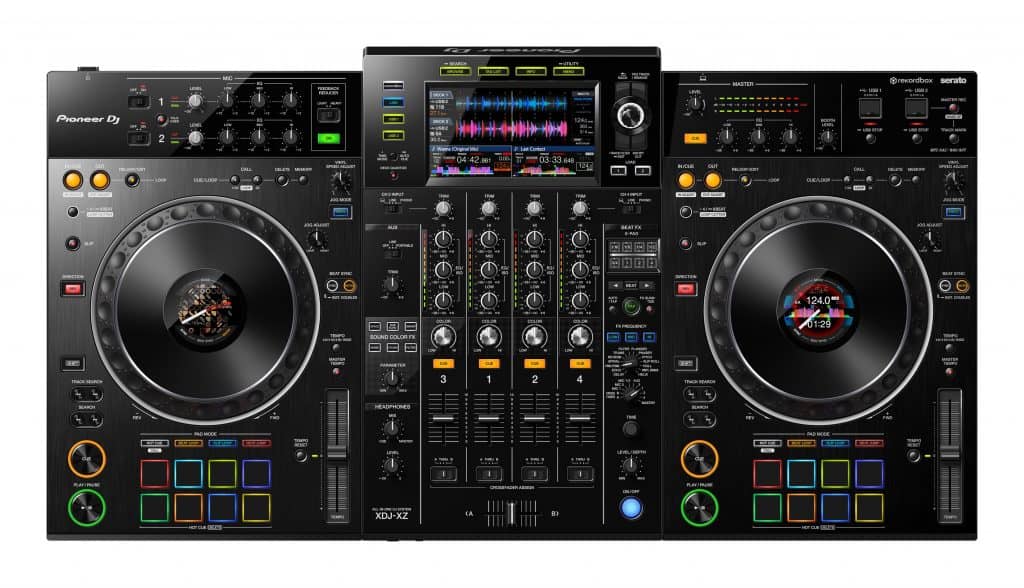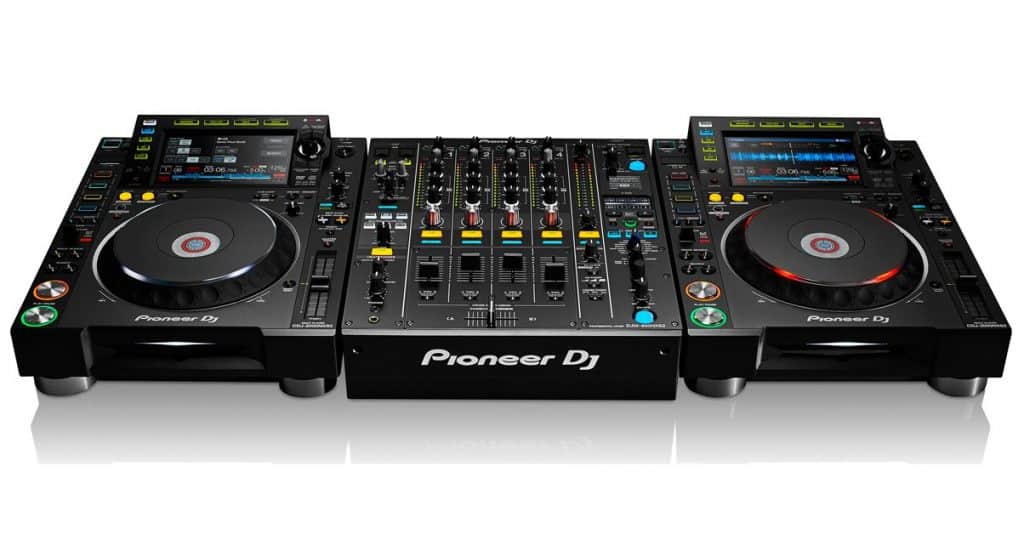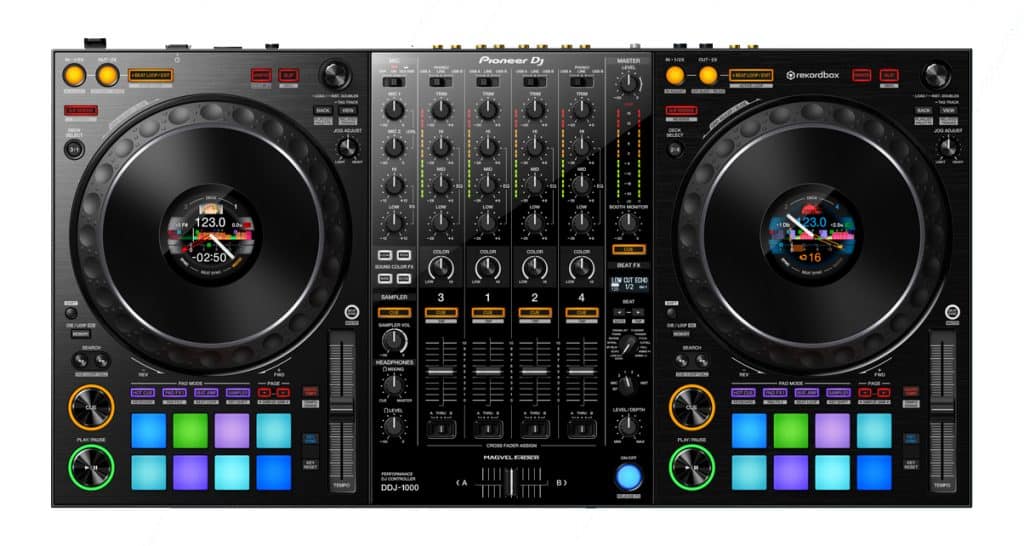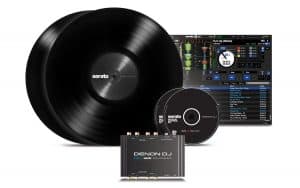The history of DJing is a story of technology and technique intertwined to optimize the art of music mixing. Andin the recent decade, there’s been more opportunities to jump in without years of collecting records and equipment allowing anybody to give it a shot. I’ll be loosely discussing the main three professional setups and explain their differences so you can decide where to begin.

Essential DJ Equipment
All DJ setups require the same quintessential pieces at minimum: Two Decks, a central Mixer, and most importantly, Music.

If you’ve even seen one professional DJ setup, you’ve seen a variation of this structure. Two big spinning plates, and the middle block full of sliders, knobs, and buttons, where cables connect to speakers.
Each deck controls one piece of music and the center controls which deck has priority in the speakers.
The priority and how each piece of music mixes together is up you, your DJ controller, and your DJ software to decide.
Now, there are 3 main variations of this basic setup.
The main three DJ setups are:
- Vinyl Records
- CDJs
- DJ Controllers
The primary differences between the three are the means to which music is played, modified, and controlled throughout a mix. Vinyl DJs require a large collection of records, CDJ users need digital music files on a physical memory device like CDs, thumb drives, and SD cards, and the Controller DJ requires a laptop and working software to contain a media library and handle a controller.
The Vinyl DJ
This is the original, the grandfather of all setups. It’s the most barebones and physical medium to play music. With Vinyl, all you need are two motorized record players (Note: not belt-drive record players), and a central mixer between the record player decks.

The record player’s stylus is directly connected from the grooves in the vinyl, through the mixer, emitting sound into the speakers.
The CDJ
The evolution of the Vinyl DJ setup, transforming the music medium with the CD (as it’s name implies), but growing to also include thumb drives and SD cards to store your music.

This setup requires two CDJ decks that read digital media, and can use the same types of mixers that vinyl DJs use. This is the ideal choice for tactile DJs who don’t want to lug around a record collection, and has become an industry standard at nightclubs.
Dj Controllers
This is the most modern, most accessible, and most visual of the three setups. The key difference here is that the two deck/mixer combination is combined into one singular DJ controller.

This is handled via a laptop connection and a specialized DJ software that compiles your music library, shows the digital track waveform, and can control sound effects like phasers/delays/reverbs at the click of a mouse or touch of a button displayed on the controller.
Vinyl vs CDJ vs DJ Controllers
Vinyl:
This setup requires a record collection. For the seasoned DJ, this means you need a lot of records. Creating a fluid and properly mixed set becomes a huge financial sink when you want to curate a stylized mix.
Vinyl can also be the most difficult to play without hours of practice. The amount of visual feedback is minimal so you’re forced to rely on your ears and finetune everything based on how it all sounds.

Taking care of your record player is also crucial to the setup, where low-quality record needles can damage your records. A bad motor can jostle your records, causing skips or jumps while playing.
Vinyl DJing can be tough, but it is ultimately extremely gratifying. It’s an art-form that requires lots of motion, discipline, a studied understanding of music, and because it’s a rarity these days, crowds tend to eat it up when you pull off a mix with finesse.
CDJs:
While this setup is the middle ground between vinyl and controller, it still requires a disciplined knowledge of tracks and where to amass your library relative to the left and right deck.
Some CDJs are more technologically advanced than others and it’s important to know what type of CDJ you’re buying. Some decks are motorized, some aren’t; some only work with CDs, some only work with thumb drives or SD cards; some have a backlit interface with digital customization and waveform images, others are closer to a graphing calculator interface.
Some nightclub/venue in-house systems are CDJ only, thus require a knowledge of the CDJ. Knowing how to use this setup can be essential knowledge if you’re trying to establish a name for yourself!
DJ Controllers:
This setup has some of the cheapest and most accessible options for anybody trying to start out without breaking the bank. Although there are many types of controllers, most companies that develop mixing software offer a “lite” or trial version of their full software that can be toyed with and used with just a laptop and mouse.
My personal suggestion is to try out different softwares (like Serato, Traktor, Virtual DJ, and more!) and decide what feels right.
A laptop is required to DJ with a controller. This means there’s an extra clunky piece of hardware that you’ll need to fit into your setup and fit onto your stand when djing in a club. It’s important to know whether or not your laptop has the proper computing power to run the mixing software.
Key Differences between each Setup
Here are my general thoughts on each setup.
On Vinyl
While record collecting can be cumbersome, there’s an intimate relationship to physical media that’s impossible to experience with digital files. Owning and playing a record requires front-to-back knowledge of an LP and feeling where your favorite tracks lie means that every move is deliberate and calculated.
On DJ Controllers
CDJs and Vinyl players sometimes argue that a laptop pulls a performer away from the crowd, claiming that eyes glued to a laptop mean that eyes aren’t focused on the people listening, not focused on reading the crowd. Something to consider when controller DJing is to not get too sucked in, although a laptop interface does provide the most visual feedback for any DJ perfectionist.
On Technique
Scratching is a fairly advanced technique, and while possible on any setup, there are some key differences in their efficacy.
Vinyl is king in this regard, where the stylus on the record player provides instant tactile feedback. CDJs can have decks that are static or motorized, where motorized decks provide a similar type of feedback when pulling back the plate for a scratch, while maintaining momentum.
The major difference is that the scratch is digitized, and can sound squelchier and more rattled than on vinyl. Controllers come in many forms, some with no decks at all, and very few with motorized plates.
Again, while it’s possible to scratch on controllers, the latency of pulling back a track, having the computer understand the action, and the sound reaching the speakers, while also using digital music, creates a somewhat undesirable modulation.
Overall: Which Setup to Choose
Above all, it’s a personal choice. Each has their own strengths and weaknesses. Vinyl is perhaps the most artistic out of all of these setups but it can be very difficult to learn and start with. If you were starting from scratch, I would go with a CDJ or a DJ controller. Once you have the basics/intermediate skills down, try out Vinyl. With Vinyl, you really feel the artistic side of DJing which is something to have as you progress further in your DJ career.
About the Author :
Kevin Foley (fresh//hell) is a longtime controller/vinyl DJ, writes for the artist collective Sine Wave Surfers, and coordinates events/curates wherever and whenever. A biochemist by trade, DJ, producer, and writer on nights and weekends. He’s had the pleasure of supporting acts like Space Jesus, KJ Sawka, Buku, Digital Ethos, Arius, Spark Arrester, and many more throughout RVA and the NRV. Well-versed in Traktor by Native Instruments, an avid record collector of funk 45’s to Vaporwave LPs, and is always digging for new tracks and sounds.
Support fresh//hell: https://soundcloud.com/fresh_hell
